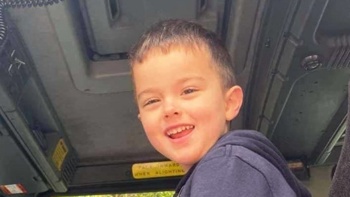
Hundreds of children living on rural roads near towns are being barred from school buses under a law that hasn't changed since 1904.
Kaipara College students Kael McFarlane and Ethan Hepper, both 13, watch a school bus go past their doors on Inland Rd 3.8km outside Helensville, but the bus is only allowed to pick up high-school students if they live more than 4.8km from school.
The road is unsealed, has no footpath and winds over a steep hill between the college and the boys' homes.
Kael sometimes walks it, taking just under an hour. He has asked if he can ride his bike, but his mother Tracey McFarlane won't let him.
"He nearly gets knocked off," she said.
Ethan's father Matt Hepper said: "We'd be happy to tell the kids to harden up if it was safe, but it's not safe."
Louise Clunie, who lives nearby on the Kaipara Coast Highway and has gathered 663 signatures on a petition to Parliament on the issue, says today's roads are vastly different from the roads of 1904.
"There were no highways, and the few motor vehicles that were in New Zealand had a speed limit of 12km/h," she told Parliament.
"Travel to school mostly involved horse drawn wagons until 1924 when the first motorised school bus was introduced. The children that did walk to school, walked across paddocks."
Today the speed limit outside Clunie's home is 100km/h. On Inland Rd, Auckland Transport reduced the limit last year from 100km/h to 60km/h, but Hepper said cars and trucks still drive fast even on the winding road over the McKenzie Hills.
"There are blind corners.
"The road gets so rutted when it's wet that you have to cross to the other side of the road, and if you have two trucks trying to pass each other there wouldn't be any room for a child."
Kael and Ethan were able to get the school bus until this year because primary school students are entitled to free school buses if they live at least 3.2km from the nearest school.
But now that they are secondary students, they must live at least 4.8km away.
A Ministry of Education spokeswoman said the limits were set in the Education Act of 1877, which introduced compulsory education for all children aged 7-13 who lived "within the distance of two miles measured according to the nearest road from a public school".
"An amendment was made in 1904 to recognise the different distances per age group," the ministry said.
"At the time, these settings reflected that walking distance was likely to represent a barrier to rural children attending schools. These established distances continue to be applied fairly and consistently today.
"While there has been no change to the criteria for over 100 years, people have greater access to transport, more vehicle options and improved roading than was available in the early 1900s."
In the Kaipara area, school buses used to pick up some students within the specified limits because they had empty seats, but they stopped doing that on the Inland Rd route last year because of population growth.
Kaipara College principal Steve McCracken said hundreds of students at Kaipara alone have been barred from the buses.
"Our roll is up nearly 30 per cent in the past three years - something that has a major impact on the funding that we get, but that doesn't equate to the service we are able to provide for buses," he said.
Andrea Clarke, principal of Kaukapakapa School, which manages the Kaipara school transport network, said Inland Rd was "just one example of a significant number of roads across our transport network where the ministry's funding criteria does not take into account accessibility or safety issues".
"We agree that it is unsafe for students to walk to school along these roads and have been petitioning government for the past two years for a review of the funding model to reflect the differences in rural/urban situations," she said.
Students in urban areas do not get free school buses because public transport exists, but most public transport operators give children discounts - between 42 and 49 per cent off adult fares on Auckland Transport buses.
In rural areas, the rules force parents inside the school bus limits to drive their children to and from school. On his first day at Kaipara College, Ethan's teacher aide drove him home.
Clunie, who has also started a Facebook campaign on the issue, pays her father to drive from Helensville to pick her children up in the morning, drive them to school, drive them back home at night and then drive back to town.
"This comes at a time when the Government is trying to discourage the use of cars due to pollution and global warming," she said.
The head of the Ministry of Education's education infrastructure service Kim Shannon said children with special needs could get exemptions and invited the Heppers to apply for Ethan, who suffered a brain injury in a dirt bike accident two years ago. But Matt Hepper said Ethan "doesn't want special treatment".
"There is no current mandate to change the school transport policy," she said.
The ministry has budgeted $221 million for school transport this year and provides free buses for about 100,000 of the country's 826,000 schoolchildren.
Then and now
1904
NZ population: 887,9040
Private cars: 3000
Open road speed limit: 12km/h
2021
NZ population: 5,112,300
Private cars: 3,485,516
Open road speed limit: 100km/h
Take your Radio, Podcasts and Music with you









